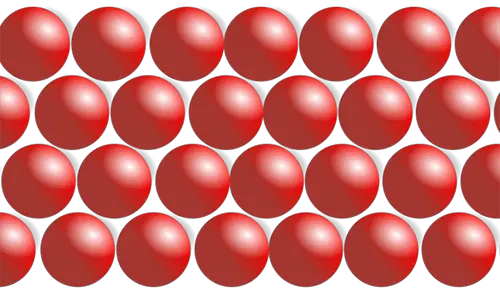There are four fundamental states of matter, namely, liquid, gas, plasma and solid. Solids possess a structural rigidity and show resistance to changes of shape or volume. A solid is different from a liquid and a gas in many respects. It cannot take the shape of its container like a liquid and also, cannot inflate to occupy the entire volume of it like a gas. In solids, the matter is composed of atoms held tightly together. It is impossible for anyone to walk through a solid wall because of the atoms packed rigidly together. Solids are able to retain their shapes at room temperature. You shall find your pencil left on the desk in your class-room, having the same shape, the next day.
Let us go through some significant facts about solids:
- The atoms in a solid are, sometimes, arranged in a regular geometric lattice and such solids are termed as crystalline solids. Examples of crystalline solids are metals and ordinary ice. The solids in which atoms are held together in an irregular way are called amorphous solids such as the common window glass.
- The behavior of solids is dependent on arrangement of the particles. As the particles of the solid are tightly bound together, there exist strong forces between them which pull the particles making the solids rigid. The particles can vibrate but are unable to move about easily. Therefore, solids are usually firm and maintain a definite shape.
- The small spaces between the atoms of a solid determine the density of matter. The atoms of gold are very tightly held together but there are more spaces between the atoms of wood. So, one inch of block of wood is not as dense as one inch block of gold.
- Diamonds are crystalline solids having regular pattern of atoms and each diamond is composed of a single crystal. Solid objects which are large enough to see and handle are composed of a large number of single crystals, called crystallites. The size of crystallites varies from a few nanometers to several meters and such solids are called polycrystalline. The amorphous solids such as polystyrene and glass do not contain a long-range order in the position of atoms.
- The differences between bonding among atoms in different solids are responsible for their dissimilarities. In metallic solids, there is presence of metallic bonding among electrons. There is presence of iconic bonds in a crystal of sodium chloride composed of iconic sodium and chlorine. Most organic compounds are held together with Van der Waals forces.
- Minerals are solids formed naturally during various geological processes under high pressures. They have a crystal structure and no specific chemical composition. The examples of minerals include the vast majority of rocks found on Earth’s crust such as quartz, feldspar, mica, chlorite, calcite, magnetite, etc.
- Ceramic solids are oxides of chemical elements made up of inorganic compounds. They are able to bear high temperatures ranging from 1000 to 1600 degree Celsius. They are, generally, brittle, hard, strong in compression and weak in sheering and tension. Examples include clay minerals such as kaolinite, aluminum oxide – silicon carbide and tungsten carbide.
- Some solids which are easily transformed into different shapes without breaking are called malleable solids. Examples are gold, silver, iron, aluminum or copper. On the other hand, solids like glass break and split easily making them brittle.
- Copper is a metallic solid having ductile properties enabling to stretch it easily into extremely thin wires. The particles in copper are held in rows which can move past one another easily.
- Solids also get transformed to other states of matter, liquids and gases, under specific conditions and vice-versa. Solids, like butter, become liquid when melted and some liquids, like water become solids (ice) when cooled. Water vapor (gas) from air that is at a subzero temperature turns into ice (solid) directly without becoming a liquid first.











Leave a Reply